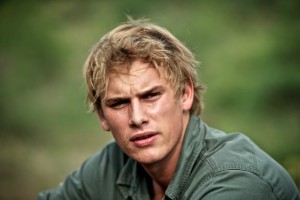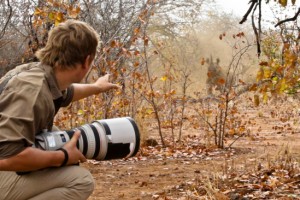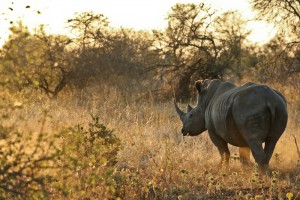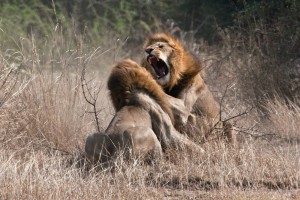What inspired you to become a safari/field guide?
I grew up near Cape Town, and first developed a love for the ocean. From a young age I started going on holidays to Kruger National Park with my family. That’s where my passion for the bush started. My father was a birder and rewarded me for the number of birds I could identify. We spent most holidays in the bush, either in the south coast, the east, or other parts of South Africa.
I had no idea what I wanted to do with my life after finishing school, so I took a year off and traveled overseas. Toward the end of the year an old friend got in touch. He owns a vineyard and sent us to Londolozi to market wine. That involved spending two weeks in the bush. I loved it and decided then and there that I wanted to live in the bush, wake up in the bush, and spend the rest of my life there.
But my parents decided I needed education, so I studied environmental studies at university. I also did the FGASA (Field Guides Association of South Africa) course, which you have to do to become a qualified guide (this involves three exams, and can take up to 6 years). So by the time I came out of uni I had the qualifications to approach Singita.
I had a slight advantage over other candidates. I did two practicals in the bush during uni, and I also got a lucky break because I knew the son of the owner of Singita. This helped me get accepted to Singita’s six-month selection course, which is basically a half-year on-the-job training course. I was 22 years old at that point.
On the course I got both practical and theoretical training. I learned how to track game, identify trees and animals, use firearms, and read animal behavior. It was one of best periods of my life, but it was also a huge culture shock going from city life in Cape Town, to waking up in the bush every day.
I passed the course, but even if you pass there is no job guarantee, so it was a bit of a gamble. Eventually I got a position at Singita Lebombo in Kruger, which comprises 15000 hectares of some of the last remaining true wilderness.
Give me an idea of a typical day in the life of a guide.
No day is the same, and this is what makes the job so appealing. Because really, people who become guides aren’t in it to make a lot of money, they are in it for the lifestyle. On a Monday you could be tracking lions, then on a Tuesday following a herd of elephants.
Most days you’re up early in the morning, when predators are most active. The feeling of being out early is like nothing else! You spend the morning walking, cycling or driving in a Land Rover. The relationship with the trackers is very important. They have been doing their job a long time and have the best instincts about where the animals are.
We only work the cooler parts of day, so we head back to camp in the late morning, then take clients out again in the late afternoon. In the evening we might gather around the fire.
While you’re doing this job you are constantly learning and teaching yourself. You have to keep your brain active.
In terms of daily routine, what are the best and worst parts of your job?
The toughest part is probably managing the people in the vehicle. It’s a huge responsibility when you have a firearm and you are around dangerous game and have to wrangle five or six clients at the same time. That’s a large weight on your shoulders.
I’ve never had an experience where I put clients on the plane home and said “thank God they’re gone,” but there are definitely challenging clients. People come for two days and expect to see something, and the pressure is on you to make that happen. You have to be able to relate to people with different needs, and sometimes with people who don’t speak English.
We work on a six-week cycle, for 12 hours at a stretch, which is tiring. It’s definitely not for the faint-hearted.
Do you have advice for visitors who are planning to go on safari in the near future?
Sit back, relax and don’t rush it. The longer you stay in the park, and the longer you stay in the vehicle, the greater your chances of seeing what you want to see. Everyone wants to get to the lions as quickly as possible, but nature has a funny way of working it out. If you let things happen, they happen. I’ve never taken people on safari and they haven’t seen big game.
Clients are briefed every day, and reminded this is not a zoo and we don’t go speeding by ticking off animals that we are going to see. It’s also about the small things out there: the bird calls, watching a bulbul.
Do you have a favorite place to guide?
It’s tough selecting one place. I’m being biased I suppose, but if I could choose one I’d say anywhere in South Africa. It’s the best in terms of game lodges, the Big Five, the culture, and the diversity of experiences you can have there. That’s what really wows people.
What’s the most nail-biting moment you’ve had on the job?
Living in the bush means you are definitely going to have some interesting encounters.
One time I was riding a motorcycle in Kruger in the tall bush, going to turn off a water pump. I was on a dirt road and suddenly came upon a male and female lion lying in road. Being around mating lions is quite dangerous, so I had to make a split second decision to turn the bike around and flee, or speed past them. Guides are taught never to run from anything … so I rode right past them. The male lion started chasing me, but thankfully lions don’t have a lot of stamina. There was good 50 yards or so when it was a little hairy, though.
Another time I was out during the summer, when the bush was quite thick, and had a close encounter with a hippo. They sometimes come out of the water and feed on grass on cloudy days, because the sun is less strong and they have sensitive skin. I was walking along a river with another guide when suddenly a hippo came charging out of the tall grass. We were right between the hippo and the water. We didn’t see him until he was about a meter away and he was making a beeline for the two of us. Luckily we were able to jump out of the way in the nick of time.
I also had a near death experience when I was stung by a parabuthid (thick-tailed) scorpion. I was out walking at night and accidentally stepped on it while I was wearing flip-flops, and was stung three times. The venom is so powerful that it put me in the ICU for five days, and for 10 days after that I couldn’t open my eyes or move. It was one of my worst experiences as a guide. That was in 2011. I learned never to walk in flip-flops in the bush, and always carry a torch at night.
What’s the weirdest, funniest, or most touching thing a guest has done while on safari with you?
We often chuckle at what clients say. “Do wildebeest hunt in packs?” You can’t forget that people are not exposed to this on a daily basis. You have to be careful to not criticize them.
There is often fear with clients, as the reality of what they are seeing hits them for the first time. Everyone who goes on safari wants to see a kill, then the most gruesome kill occurs in front of them and half the vehicle is in tears or wants to leave. Or we’ll come around a corner and see lions, and the guests will cower and hide.
What exposure have you had to poaching?
As a guide you are really exposed to poaching, and I’ve had first hand experience with it — Kruger is a hotspot, unfortunately. We rely on vultures to find predators, but there have been cases when I have been guiding and instead of locating what we were looking for, we come across corpses.
One time when I was guiding I came across a rhino that had been de-horned and left to die. It’s really hard to see Africa’s population of rhinos slowly disappear. But South African parks and reserves are doing phenomenal things to combat poaching. One park has a dog unit, and others are joining forces with the military and the South African Police Force.
How long have you been interested in photography? When did you start, and what was your training, if any?
My interest in photography started when I first started my guiding career. I had such amazing experiences with wildlife almost every day. I wanted to be able the remember these experiences and share them with others.
Do you have tips for how to get the best photos?
Having a skilled photographic guide is the most important thing for getting the best pictures. Wildlife photography is all about being able to read animal behavior.
You will be constantly changing your camera settings depending on the shot you are looking for, as well as the subject you are shooting and the action performed by the subject.
Another important aspect is not to shoot down on an animal. Shoot at eye level, which is best achieved on foot.
Being able to capture a moment — an image that tells a story — is what I’m after every time I pick up my camera.
How is important is light to a good photo? Is it ever possible to take a good photo in harsh mid-day light?
Light is important — the “golden hour” (in the early morning or late afternoon) is always great.
However with today’s technology one is able to manipulate images, and this can assist with turning a very average image into a usable image. For example, manipulating an image using a monochrome (b/w) setting or bracketing can assist with lack of good light.
Is a long telephoto lens essential, or can good photos be taken with a point-and-shoot camera (such as a Canon Powershot)?
The best camera is the camera you have on you — whether an iPhone or the latest DSLR. However for wildlife photography I would recommend a telephoto lens.
Having a telephoto lens is imperative. You don’t want to interfere with the animals, so you have to be far enough away that you can photograph at a safe distance. Also, a fast lens (2.8) and a driver who can position the vehicle quickly and effectively is very helpful.
If you do not have a 600mm lens you can still crop (zoom in) on an image in post production, which means you can still capture great images without a long lens. This also depends which reserves you visit in Africa — some reserves have animals that are very habituated to the vehicles, allowing you to get closer to your subject.
What are your top tips for taking great video?
With video it is easier to tell a story. But to be able to shoot good video on a DSLR you need a tripod/shoulder rig, or a very steady hand.
My advice for how to get good video is the same as my advice for taking images with a still camera.
Is it possible to take good photos or video at night?
With the correct rig and setup it is possible to take good images, and one can have a lot of fun shooting at night. With regards to video … one is really limited in the dark.
Any tips for photographing people?
Always respect people: ask permission before just snapping away.





